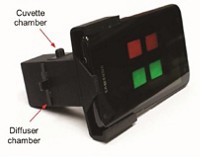Advertisement
Grab your lab coat. Let's get started
Welcome!
Welcome!
Create an account below to get 6 C&EN articles per month, receive newsletters and more - all free.
It seems this is your first time logging in online. Please enter the following information to continue.
As an ACS member you automatically get access to this site. All we need is few more details to create your reading experience.
Not you? Sign in with a different account.
Not you? Sign in with a different account.
ERROR 1
ERROR 1
ERROR 2
ERROR 2
ERROR 2
ERROR 2
ERROR 2
Password and Confirm password must match.
If you have an ACS member number, please enter it here so we can link this account to your membership. (optional)
ERROR 2
ACS values your privacy. By submitting your information, you are gaining access to C&EN and subscribing to our weekly newsletter. We use the information you provide to make your reading experience better, and we will never sell your data to third party members.
Environment
Spray-on detector makes lead light up green
Chemical reacts with lead instantly to form fluorescent perovskite
by Payal Dhar, special to C&EN
December 18, 2023

Lead contamination and exposure can cause “ profound and permanent ” impacts, including brain damage in children, and increased risk of kidney damage, cardiovascular disease, and miscarriage, according to the World Health Organization. While known contamination is relatively easy to mitigate, the detection itself can be a tricky proposition. Standard methods can only detect lead if it’s isolated and concentrated first.
Now, researchers at Amolf, a research institute dedicated to studying the physics of matter, have developed a spray-on reagent that signals the presence of even tiny amounts of lead by lighting up fluorescent green under a UV light within seconds. Comprised of methyl ammonium bromide in isopropanol, it reacts with lead to form a photoluminescent lead bromide perovskite (Environ. Sci. Technol. 2023, DOI: 10.1021/acs.est.3c06058) .
Gabriel Filippelli, a biogeochemist at Indiana University-Purdue University Indianapolis, who wasn’t involved in study but did test a beta version of the spray, says that it is both sensitive, quick, and accurate, detecting lead in a way that is obvious to the eye. According to the researchers, the reagent does not react with similar metals like tin or copper, and it can detect lead on glass, plastic, concrete, soil, metal, paint, and more. “We can [even] spot nanograms of lead in laboratory conditions,” says Wim Noorduin, the lead author of the study. The color emitted by the perovskite depends on the halide; bromide causes it to appear green.
“What’s special about our [test] is that we . . . just do it in the environment,” Noorduin says. In fact, the researchers were surprised by the versatility and robustness of the reaction, which detects lead in different oxidation states and with different counter ions. The researchers spent two years developing the reagent, but for a different use—to make perovskites from the calcium carbonate in the shell of creatures like sea urchins. They discovered its potential as a lead detector by accident, when Noorduin took it home and happened to spray it on his neighbors’ roof.
The exact mechanism of the reaction is still a mystery, and the researchers continue to study the pathways and feedback mechanisms behind it. Meanwhile, Noorduin, co-author Lukas Helmbrecht, and two others have already developed a test kit that they sell through the company Lumetallix. Their kits have been used in a study in the Ivory Coast in which pregnant women are testing their homes for lead.
“We need tools like this that can provide a first-line triage of lead sources in the environment,” Filippelli says. He calls this research a breakthrough in rapid, accurate testing for environmental lead because it makes the metal’s presence so visibly apparent. “I believe it will motivate households to take steps to reduce or eliminate lead . . . within their home environment.”
CORRECTION:
This story was updated on Dec. 19, 2023, to correct the name of the institution where this research was done and to correct the image credits. In all cases the name is Amolf, not the FOM Institute for Atomic and Molecular Physics.




Join the conversation
Contact the reporter
Submit a Letter to the Editor for publication
Engage with us on Twitter